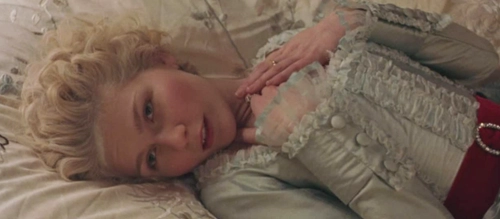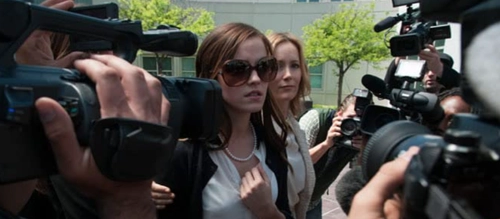Sofia Coppola Movies Ranked
A young girl lying on her side in a field, drenched in blue dawn. Neon city lights through the distortion of a car window, its smudged colors cool and isolating. Sunlight streaming through the leaves of a Virginia wood, silent and unnerving. A marble countertop, strewn with diamonds and pink lipstick.
These and countless more are the images that come to mind when you think of the movies of Sofia Coppola. They invoke a flurry of emotions and snapshots of memories. The heartbreak of first love and the loneliness of living in a foreign city. Sexual repression bubbling just below the surface. Material wealth – beautiful and shallow.
Coppola combines her love of fashion, photography and music to create a distinct visual style of hyper-femininity and pastel hues that runs throughout all of her movies. The eldest daughter of filmmaking legend Francis Ford Coppola, Sofia dabbled in a bunch of creative pursuits before setting her sights on directing. She interned with Chanel in Paris, studied painting, starred in several music videos, and even had bit parts in films like Peggy Sue Got Married and Frankenweenie (raise your hand if you can pick her out among Padme Amidala’s handmaids in Star Wars: Episode 1 – The Phantom Menace.)
Her first project, Lick the Star, a 14-minute short film released in 1998, is the root from which all her other works branch off, and it’s a fascinating glimpse into who she would become as a filmmaker. Often straying from conventional narrative form, Coppola’s movies are decidedly feminine and delicate, exploring themes of celebrity, girlhood, wealth, and privilege.
Her own wealth and privilege have been the subject of much discussion. Her performance as Michael Corleone’s daughter, Mary, in her father’s movie, The Godfather Part III (1990), was eviscerated by critics. Claims of nepotism were ramped, overshadowing the release of her debut feature film, The Virgin Suicides. But in time, and with an Oscar for Best Screenplay under her belt, Coppola emerged as an artist in her own right, with a unique vision and directorial style. She was the first American woman to win the Golden Lion at the Venice Film Festival (for Somewhere, 2010) and was the second woman ever to win Best Director at the Cannes Film Festival (for The Beguiled, 2017).
In this edition of Ranked, we at The Film Magazine will analyze all right of Sofia’s Coppola’s feature films, evaluating each one based on its direction, writing, and performances, as well as how critical reception has changed over time. From her low budget debut The Virgin Suicides to her recent Apple TV exclusive One the Rocks, these are the Sofia Coppola Movies Ranked.
Follow @thefilmagazine on Twitter.
8. Marie Antoinette (2006)

Marie Antoinette and the Art of Historical Inaccuracy
Marie Antoinette, starring frequent Sofia Coppola collaborator Kirsten Dunst, was released just three years after Lost in Translation. Taking place over the course of around sixteen years, the movie begins with Marie Antoinette’s marriage to Louis XVI of France (Jason Schwartzman) and ends with revolutionaries storming Versailles and the royal family fleeing to Paris.
The film begins with Marie Antonia, just 14 years old, as she cuts all ties to her home country and her authentic self. It’s a striking image – a young girl dressed up like a doll, her face powdered white, hair sprayed thickly, and dressed in expensive fabric and jewels. Coppola seems to be saying: this is the story of a girl who will come to use her wealth as a shield. She will sink deeper into gluttony and extravagance to make up for the emptiness inside of her.
Unfortunately, the movie doesn’t do much with this idea. We don’t really get to know Marie Antoinette at all. Coppola seems far more interested in displaying her wealth and privilege instead of saying anything about it. Though it’s set against the backdrop of the French Revolution, the political and socioeconomic anxieties of the time are non-existent. It’s easy to see what Coppola was trying to do – by ignoring the situation outside the palace walls and distracting us with lavish jewels and decadent desserts, she shows how the royal family did the same thing. Unfortunately, it doesn’t have the desired effect. Rather than a critique of the royal family’s ignorance and the emptiness of excess, it feels empty.
Though Coppola is known for her melancholic pacing, Marie Antoinette drags. Contemporary music tries to instil some life into it, but the rhythmic pop ballads feel out of sync with the editing. The costume and production design are obviously incredible. It’s simply a feast for the eyes. Every single inch of every single frame is covered in rich fabrics and wigs piled high. But while it is lavish and the colors are rich and vibrant, they ultimately overshadow the interiority of the characters and the ending falls flat because of this.
Recommended for you: 10 Unsung Women Filmmakers of the Silent Era
7. The Bling Ring (2013)

While Marie Antoinette fails as a critique of the shallowness of material wealth, The Bling Ring absolutely nails it.
Based on the 2010 Vanity Fair article “The Suspect Wore Loubitouns” by Nancy Jo Sales, the movie tells the story of the real-life bling ring, a group of fame-obsessed teenagers who burglarized several celebrity homes in and around Calabasas, California. The movie also takes inspiration from the short-lived E! reality show, ‘Pretty Wild’. (If you know, you know.)
The Bling Ring is over the top in the best way. While Marie Antoinette plays things a little too straight, The Bling Ring is an obvious satire on how fandom and reality TV, as well as overconsumption, has rotted our brains. It also features a much better use of pop music. The frequent needle drops, especially “212” by Azealia Banks, infuse the movie with an energy and rhythm that just wasn’t accomplished in Marie Antoinette.
Though it was criticized for not taking a moral stance on the characters’ behaviors and actions, The Bling Ring is obviously not saying that breaking into people’s houses is a good idea. Coppola doesn’t patronize. Instead, she gives us a glimpse at how it feels to live on the edge of fame, caught between being known and being no one. In a lot of ways, The Bling Ring prophesied the current state of popular culture.

